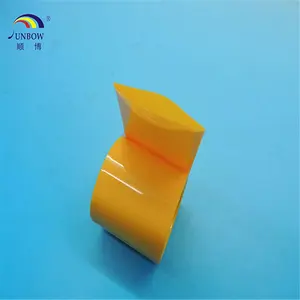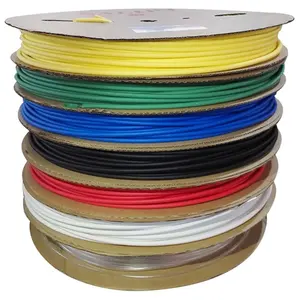What is Shrink Tube Heat Applications
Shrink tube heat applications, commonly referred to as heat shrink tubing, are a versatile material used in the electrical and electronics industries for protecting and insulating wires and cables. This tubing is designed to shrink when exposed to heat, hence the name 'shrink tube'. The primary component of heat shrink tubing is polymer, typically a plastic such as polyethylene, which is irradiated with electron beams to cross-link the material. This process gives the tubing its shrinkable properties. When heat is applied to the tubing, it shrinks uniformly around the cable or wire, providing a tight, secure seal that protects the underlying wire from environmental factors, abrasion, and other potential damage.
Shrink tube heat applications are diverse and cater to a wide range of users, from electrical engineers and technicians in high-tech industries to DIY enthusiasts working on home improvement projects. The principle behind its use is simple: By applying heat to the tubing, it shrinks and conforms tightly to the contours of the wire or cable it's meant to protect. This creates a secure barrier against moisture, chemicals, and general wear and tear.
Industries that commonly use shrink tube include telecommunications, aerospace, automotive, and consumer electronics. These sectors often require reliable insulation and protection for their components, making shrink tube an essential material for both professional and personal use. The tubing's ability to provide a protective covering while maintaining flexibility and its resistance to harsh environments makes it an ideal solution for cable management and electrical insulation.
Types of Shrink Tube Heat Applications
In the world of shrink tube heat applications, versatility is key. Different types of tubes cater to specific needs within various industries:
-
Polyolefin Shrink Tubing: Known for its durability and resistance to chemicals, this type is often used in the electrical and automotive industries. Its tight shrink ratio allows for a snug fit over cables and wires.
-
Polyester Shrink Tubing: Offering a high shrink ratio and excellent strength, polyester shrink tubing is frequently utilized in the labeling and packaging sectors. It provides a clear and secure seal for products.
-
PTFE Shrink Tubing: With its ability to withstand extreme temperatures and provide a non-stick surface, PTFE shrink tubing is ideal for applications such as medical devices or in any situation where a high degree of heat resistance is required.
-
PE and PVC Shrink Tubing: These are widely used for general-purpose shrink packaging in various industries. PVC has good chemical resistance and is often used for packaging products that might be exposed to oils or other chemicals.
-
HDPE Shrink Tubing: Typically utilized in the packaging of products like bottled beverages or personal care items, HDPE is known for its flexibility and is often chosen for its ease of use in manual packaging tasks.
How to choose Shrink Tube Heat Applications
Selecting the right shrink tube heat applications involves understanding the specific needs of your business operations. Consider the following factors when choosing shrink tube heat applications:
-
Material Properties: Evaluate the environment in which the shrink tube will be used. If exposure to high temperatures is a concern, opt for materials like PTFE or Polyolefin that offer exceptional heat resistance. For general purpose applications, materials like PE or PVC may suffice.
-
Size and Fit: The size of the shrink tube should correspond with the dimensions of the items being protected. Ensure a range of sizes is available to accommodate different applications.
-
Shrink Ratio: The shrink ratio determines how much the tubing will shrink during the heating process. A higher shrink ratio provides more protection and often allows for a tighter fit around irregularly shaped items.
-
Ease of Application: Some shrink tubing can be applied more easily than others. Consider the user's skill level and whether specialized equipment is available.
-
Chemical Compatibility: If the shrink tube will come into contact with chemicals, it must be made from a material that is chemically inert to prevent degradation over time.
By taking into account these considerations and utilizing Alibaba.com's vast selection of suppliers offering different types of shrink tube heat applications, businesses can find a product that meets their specific industrial needs.
About Shrink Tube Heat Applications on Alibaba.com
Alibaba.com stands out as a premier online marketplace that connects businesses with a vast selection of shrink tube suppliers from around the globe. With its user-friendly platform and support for multiple languages, Alibaba.com offers an unmatched shopping experience tailored to meet the specific needs of B2B customers. The platform's commitment to facilitating seamless trade across international borders ensures that businesses can find high-quality shrink tubes that cater to their varied industrial applications.
The site's extensive catalog includes products made from durable materials such as PE, polyolefin, silicone rubber, PTFE, and more—each available in a wide range of colors and features. Whether you're looking for eco-friendly options or heat-resistant materials for your project needs, Alibaba.com's vast network of suppliers provides ample choice without compromising on quality.
Moreover, with features like Trade Assurance, businesses can purchase shrink tube with confidence knowing their payments are protected until delivery is completed. The platform's commitment to supporting small and medium-sized businesses through comprehensive online trade solutions makes it an ideal source for procuring not only shrink tubes but also other essential wiring components. This focus on reliability and customer satisfaction makes Alibaba.com an indispensable ally for businesses seeking to streamline their sourcing processes and acquire materials that will ensure their products' performance and safety standards are met.
Common FAQs for Shrink Tube Heat Applications
What is the difference between PE and PTFE shrink tubes?
PE shrink tubes are made from polyethylene and are generally used for electrical insulation and cable harnessing due to their durability and moisture resistance. PTFE shrink tubes, on the other hand, are manufactured with a special type of fluoropolymer that provides exceptional chemical resistance, making them suitable for high-temperature and chemically harsh environments.
Can PE and PTFE shrink tubes be used outdoors?
PE shrink tubes are UV-resistant, which makes them suitable for outdoor applications. PTFE shrink tubes offer additional protection with a non-stick surface, making them a good choice for both indoor and outdoor environments where chemical resistance and non-stick properties are required.
Are there clear heat shrink tubes available for branding purposes?
Yes, clear heat shrink tubes enable customization with printing or labeling for branding purposes. They are available in both PE and PTFE materials and are ideal for businesses that want to mark their products or equipment.
How do I choose the right size of PE or PTFE shrink tube for my application?
The right size of PE or PTFE shrink tube is determined by the diameter of the object being covered and the specific application requirements. It's important to select a tube size that fits snugly and meets the operational needs of the project.
Is it possible to have more than one type of shrink tube on a single application?
Depending on the application's requirements, it may be possible to use different types of shrink tubes within one system. Always verify compatibility before mixing different types of shrink tubes in the same application.
What are the common uses for heavy-duty shrink tube?
Heavy-duty shrink tubes are designed to provide mechanical protection and abrasion resistance in industrial settings. They are used in applications such as electrical insulation for cables and wire harnesses in automotive, marine, and other heavy machinery.
How does the operating temperature impact the performance of a shrink tube?
The operating temperature range should be considered when selecting a shrink tube, as different materials offer varying degrees of heat resistance. It is crucial to choose a tube that can withstand the temperature extremes it will be exposed to during use.
Can I use a standard heat gun to apply heat shrink tubes?
Standard heat guns are typically used to apply heat shrink tubes, but the specific model and settings will depend on the heat shrink tube's material composition and the required shrinkage ratio. Always refer to the manufacturer's guidelines for best results.
What should I do if my heat shrink tube does not shrink evenly on my application?
If the heat shrink tube does not shrink uniformly, check if it is made from material designed to shrink at the correct temperature and if the heat gun is being applied correctly. If issues persist, consult with the supplier for guidance or consider using a different type of heat shrink tube.
Are there eco-friendly shrink tubes options available?
Yes, there are eco-friendly heat shrink tubes available that are made from materials that are biodegradable or have a lower environmental impact. These options are increasingly popular among businesses focused on sustainability.
How do I determine if I need a thin-wall or medium-wall heat shrink tube?
The choice between thin-wall and medium-wall heat shrink tubes depends on the application's specific requirements. Thin-wall tubes offer more flexibility and conformability to irregular shapes, while medium-wall tubes provide greater mechanical strength and durability.
Can I use colored heat shrink tubes for specific applications?
Colored heat shrink tubes are commonly used to identify different wires or cables in electrical installations. For instance, red or black tubes might be used to indicate power conductors, while green could signify grounding or earth connections.











































 浙公网安备 33010002000092号
浙公网安备 33010002000092号 浙B2-20120091-4
浙B2-20120091-4